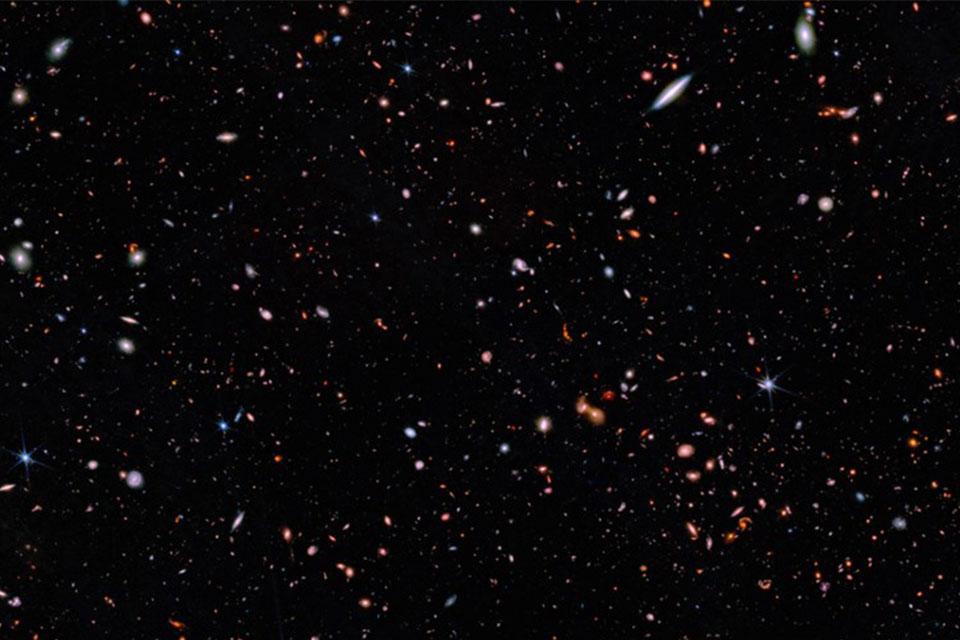Two papers published today in Nature Astronomy present the discovery of four of the most distant galaxies yet found. The observations were made with the NASA James Webb Space Telescope (JWST), which launched on Christmas Day 2021. JWST is a bigger telescope than the Hubble Space Telescope, and can work at longer wavelengths, which makes it an ideal machine for finding very distant galaxies, which are faint and also highly redshifted by the expansion of the Universe.
The work was done by the teams which built two of the key instruments for JWST – the near-infrared camera (NIRCam) and the NIRSpec spectrograph. NIRSpec is a European Space Agency contribution to JWST, and its instrument science team is based across six leading European universities, including the University of Oxford.
Hubble + JWST
The astronomers studied a small patch of sky called the Ultra Deep Field, which is the most sensitive image of the Universe ever taken by the Hubble Space Telescope. By combining the images from Hubble taken through various different filters with new images from NIRCam on JWST at longer wavelengths, the astronomers identified four galaxies whose colours were consistent with very high redshifts, the fingerprint of galaxies at enormous distances. Two of these were faintly visible in the Hubble images, but two new candidate distant galaxies could only be seen with JWST.
The team then turned to NIRSpec to take a spectrum of these candidates, and this proved that indeed these faint red objects really are distant galaxies. The signature of a sharp cut-off in the spectrum at the wavelength of the hydrogen transition to the first excited state showed that these are galaxies embedded in mostly neutral hydrogen gas at immense redshifts. ‘The spectroscopic confirmation is extremely important, and has not been possible until JWST,’ confirms Professor Andrew Bunker, a member of the NIRSpec Instrument Science Team at the University of Oxford. ‘Without this proof, we could not know for sure the true distances to these faint red objects.NIRSpec is not only much more sensitive than any previous spectrograph at these wavelengths, but also can observe many hundreds of objects at once.
Astronomical equivalent of archaeology
‘Light left these galaxies when the Universe was extremely young, and light has been travelling for most of the age of the universe (13.7 billion years) to reach us,’ he explains. ‘All the galaxies are seen within half a billion years of the Big Bang, and the furthest is seen when the Universe was less than a quarter of a billion years old. By discovering galaxies at early times and comparing with more nearby galaxies when the Universe was older, we can study the formation and evolution of galaxies – the astronomical equivalent of archaeology.’
The four galaxies are forming stars, and have a low abundance of heavy elements. This is expected for young galaxies, since all elements heavier than lithium are not born in the Big Bang but instead form in nuclear processes in stars, and are slowly enriched over time.
‘This is still just the early phase of JWST’s mission,’ adds Dr Alex Cameron, astronomer at the University of Oxford and one of the core authors on the NIRSpec spectroscopic paper. ‘It is one thing to find these galaxies, but as the mission progresses we will also continue to develop our understanding of the properties of these early galaxies. This is an exciting early step in a much longer process.’
Faintest and furthest galaxies
Professor Bunker concludes: ‘I joined the NIRSpec instrument team for JWST back in 2005, and it is fantastic to see that now JWST has finally launched, it is detecting the faintest and furthest galaxies yet seen. Taking a spectrum with NIRSpec is key to confirming their distances, and to understanding the nature of these galaxies in the early universe – how fast they are converting their gas into stars, and how rapidly heavy elements are being built up in these stars.’
The team at Oxford who were involved in this study is supported by the First Galaxies Advanced Grant from the European Research Council. The team includes Professor Andrew Bunker, Dr Alex Cameron, Dr Jacopo Chevallard, Dr Gareth Jones and Dr Aayush Saxena, as well as graduate student Imaan Wallace.
Identification and properties of intense star-forming galaxies at redshifts z > 10, B E Robertson et al, Nature Astronomy, 4 April 2023
Spectroscopic confirmation of four metal-poor galaxies at z = 10.3–13.2, Emma Curtis-Lake et al, Nature Astronomy, 4 April 2023

